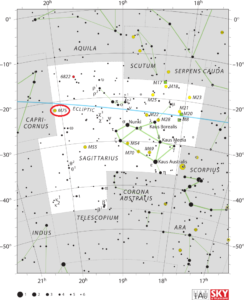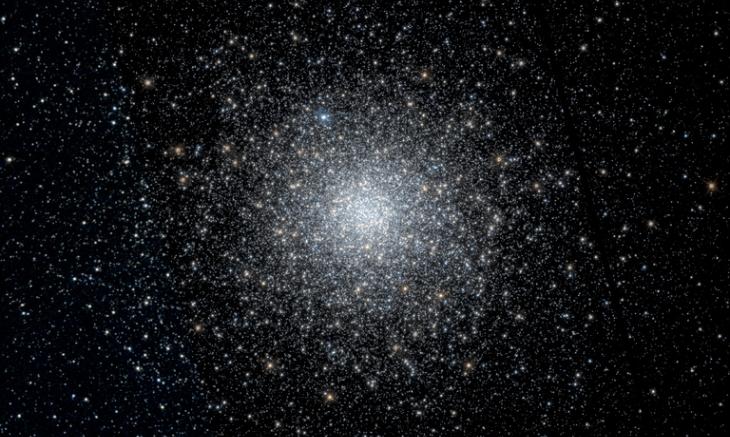Messier 75 is the most centrally concentrated globular cluster in the entire Messier catalogue, with about 400,000 stars. It also known as NGC 6864 and is a globular cluster of stars in the southern constellation Sagittarius. It was discovered by Pierre Méchain in 1780 and included in Charles Messier’s catalog of comet-like objects that same year.
| Description | |
| Visible From Pacific Northwest | June to September |
| Best Time To Observe | August |
| Minimum Size Of Viewing Device | Small Telescope |
| Object Type | Globular Cluster |
| Designations | Messier 75, M75, NGC 6864, GCl 116 |
| Right Ascension | 20h 06m 04.75s |
| Declination | -21°55’16.2” |
| Constellation | Sagittarius |
| Number Of Stars | 400,000 |
| Apparent Magnitude | +9.18 |
| Absolute Magnitude | -8.5 |
| Apparent dimensions | 6′.8 |
| Object Radius | 67 light years |
| Distance From Earth | 67,500 light years |
History
Messier 75 was discovered by Charles Messier’s friend and colleague Pierre Méchain on the night of August 27 to 28, 1780. Messier observed the cluster in October, determined its position, and added it to his catalogue as object number 75 on October 18 of that year.
William Herschel resolved the cluster into stars in 1784 and called it a “miniature of the third” (Messier 3).
John Herschel catalogued M75 as h 2064 and later included it in the General Catalogue as GC 4543. He noted, “globular cluster; bright; pretty large; round; very much brighter to the middle where there is a bright nucleus; partially resolved/some stars seen.“
Locating M75 In The Sky
The cluster is located in the eastern part of Sagittarius constellation, right next to the border with Capricornus. It can be found roughly 23 degrees from the centre of the Teapot asterism.

Viewing M75
The best time of year to observe M75 is during the summer. The distance of M75 makes it challenging to resolve the cluster with small telescopes. One needs a 10-inch or larger telescope to see the cluster’s stars. In binoculars, the cluster can barely be distinguished from the neighbouring stars, while 4-inch telescopes reveal a hazy patch of light.
Photographing M75
Messier 75 looks great in photograph and, despite its apparent size, can reveal lots of details. Simply make sure to not overexpose your image and get a good guiding graph before attempting to capture it. There are a few guides for M75 on the Internet, which can really be found one astrobin and cloudy nights. It is a great summer target, just make sure to utilize accurate guiding to help the stars remain crisp and appropriate filters and exposure time to gather all the data for detailed images.
Sources And Further Reading
Descriptions of all of Messier Objects can be found here.
https://www.nasa.gov/feature/goddard/2018/messier-75
https://freestarcharts.com/messier-75

Be the first to comment on "Messier 75"